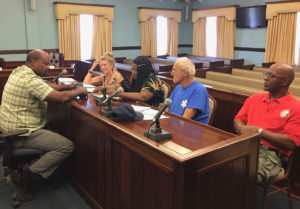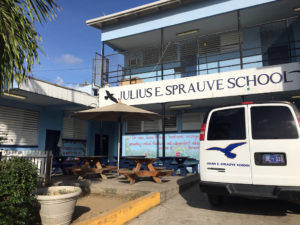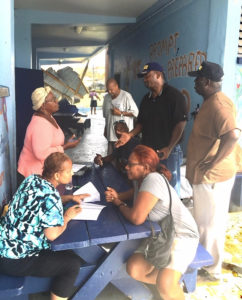
Hurricane Dorian gave St. John officials a chance to find out exactly how watertight the island’s only hurricane shelter is, and the answer is – not very.
During the storm, water poured in through the walls and under the doors of the shelter at the Julius E. Sprauve School, flooding the rooms where 11 people sought shelter from the storm. That number includes shelter volunteers. Notably, sandbags were not issued in the St. Thomas-St. John district.
On the bright side, the roof repairs made following Hurricane Irma in 2017 held up.
“It’s hard to shelter in a hurricane damaged building,” said Celia Kalousek, executive director of the St. John Community Foundation.
The Sprauve School shelter was opened on the morning of Aug. 28 as an “evacuation shelter” shortly before Dorian morphed from a tropical storm to a Category 1 hurricane. The shelter is located in several of the back classrooms.
Kalousek was one of four people who attended a meeting Wednesday afternoon called by Sen. Steven Payne to discuss what worked – and what didn’t – during Hurricane Dorian. They conversed by phone with Denise Lewis, deputy director of VITEMA.

They were joined by Abigail Hendricks and Ronnie Jones of the Department of Human Services on St. John, and one other volunteer. Human Services is responsible for operating shelters and mass feeding following disasters.
Hendricks said that during the storm a Red Cross volunteer called a supervisor to get approval to deploy cots when water on the floor reached ankle-height. Cots, food, and blankets are not among the amenities offered in evacuation shelters, which are intended to function only for the duration of the storm itself.
On the morning of the storm, radio announcements advised storm victims choosing to go to temporary evacuation shelters to bring their own food, chairs, bedding, and flashlights in addition to the usual list of emergency supplies.
Kalousek said that many of those who went to the Sprauve School were homeless and were not able to provide their own supplies and equipment. They stayed at the school until the curfew was lifted Thursday morning.

A generator in the school cafeteria, which hasn’t worked since before Hurricane Irma struck, still must be replaced. Payne said he was working with the Department of Education to move in another generator which will remain on site. The generator in the cafeteria would have been needed if the storm had been more serious and “mass feeding” became necessary. Mass feeding usually begins 72 hours after a disaster strikes. Until then, shelter users are usually given MRE’s, Meals Ready to Eat, developed by the military for use by armed service members in the field.
Payne said he would also ask officials to erect an antenna on the building that will allow amateur radio operators to communicate with shelter managers.
Payne said Dorian gave everyone a lesson in storm preparation.
“If we’re expecting a Category 1 storm, let’s prepare at least for a Category 3,” he said.
Last year, St. John residents were advised to go to a shelter on St. Thomas if a storm approached because the Sprauve School does not meet the standards required to serve as a certified shelter
Hendricks said shelter operators are now confident that that the Sprauve School is a safe place for St. John residents to weather a storm. “We have many resources that were not available before 2017. We have had the opportunity to learn where the dry places are at the Sprauve School, thanks to Dorian, so I’m confidant we’re going to be okay.”
Editor’s note: This has been updated to correct the location of the shelter within the Sprauve School.


